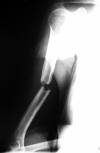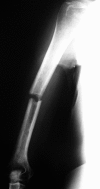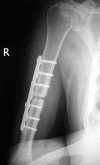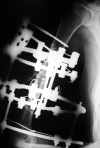Ilizarov treatment of humeral shaft nonunion in an antiepileptic drug patient with uncontrolled generalized tonic-clonic seizure activity
- PMID: 20667134
- PMCID: PMC2919461
- DOI: 10.1186/1749-799X-5-48
Ilizarov treatment of humeral shaft nonunion in an antiepileptic drug patient with uncontrolled generalized tonic-clonic seizure activity
Abstract
Nonunion of the humeral shaft in patients with antiepileptic drug associated metabolic bone disorder constitute a challenging surgical problem difficult to treat due to seizure activity, osteoporosis, and poor stabilization options. We report a case of nonunion of the humeral shaft in an antiepileptic drug patient with uncontrolled generalized tonic-clonic seizure activity successfully treated with Ilizarov external fixator and a follow-up of 4 years.
Figures








Similar articles
-
Treatment of the humeral shaft aseptic nonunion using plate or unilateral external fixator.J Trauma. 2008 May;64(5):1290-6. doi: 10.1097/TA.0b013e3180582471. J Trauma. 2008. PMID: 18469652
-
Treatment of the humeral shaft nonunion after surgical failure using the Selfdynamisable internal fixator.Arch Orthop Trauma Surg. 2007 Oct;127(8):713-8. doi: 10.1007/s00402-007-0331-x. Epub 2007 Apr 25. Arch Orthop Trauma Surg. 2007. PMID: 17457596
-
Lamotrigine adjunctive therapy among children and adolescents with primary generalized tonic-clonic seizures.Pediatrics. 2006 Aug;118(2):e371-8. doi: 10.1542/peds.2006-0148. Epub 2006 Jul 17. Pediatrics. 2006. PMID: 16847080 Clinical Trial.
-
Nonunion of the humerus following intramedullary nailing treated by Ilizarov hybrid fixation.J Orthop Trauma. 1998 Feb;12(2):138-41. doi: 10.1097/00005131-199802000-00013. J Orthop Trauma. 1998. PMID: 9503305
-
[First generalized tonic-clonic seizure].Tidsskr Nor Laegeforen. 2015 Aug 11;135(14):1256-8. doi: 10.4045/tidsskr.14.0654. eCollection 2015 Aug 11. Tidsskr Nor Laegeforen. 2015. PMID: 26269067 Review. Norwegian.
References
-
- Brinker MR, O'Connor DP. The incidence of fractures and dislocations referred for orthopaedic services in a capitated population. J Bone Joint Surg Am. 2004;86:290–7. - PubMed
-
- Healy WL, White GM, Mick CA, Brooker AF Jr, Weiland AJ. Nonunion of the humeral shaft. Clin Orthop Rel Res. 1987;219:206–13. - PubMed
LinkOut - more resources
Full Text Sources

